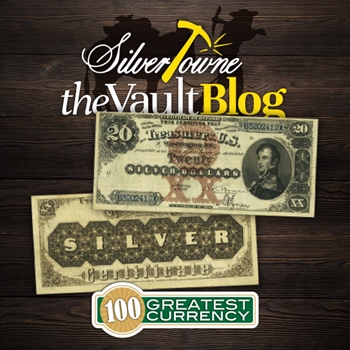
By now it is apparent that rarity is one of the major contributors to a currency note being selected for such a list as Whitman Publishing’s 100 Greatest American Currency Notes compilation. Another one is the intended use for the note at the time it was printed. Both of those things make up the reason for this next entry in our blog series following along with the top 100 picks curated by authors Q. David Bowers and David M. Sundman.
#28 - Prominent “Silver” Back $20 Silver Certificate, Series of 1878 and 1880
Series of 1878 $20 Silver Certificates are rare and feature countersignatures in addition to the Treasury signatures. The Series of 1880 notes are a little different in design and have just two Treasury signatures. The latter of the two is more scarce with around 300 actually known to exist with examples exuding substantial wear, indicating their heavy usage during their time.
The face of the note features the portrait of Stephen Decatur, a naval hero Commander on the United States. Decatur signed on as a midshipman when the United States Navy was established in 1798. By 1804, he made a name for himself during an action against the Barbary pirates in the Mediterranean in which the Philadelphia was neutralized after falling into enemy hands. Decatur and his fellow shipmates overcame the enemy crew and set fire to the ship making it useless. In 1812, now Captain Decatur and his sailors captured the British ship Macedonia. After the War of 1812 ended, he moved to Washington, D.C., with his wife hoping to live a long life. Unfortunately he was killed in a duel in 1820 by disgraced Navy captain, James Barren. He was court-martialed and Decatur helped do so.
While he lived a short life, his accomplishments landed him on the face of the $20 Silver Certificates of 1878 and 1880. The word SILVER can be seen on the back in large letters. The objective of the notes was to increase demand for silver and help support the price drop of the metal. Use for silver coinage was waning at the time but new silver discoveries were continually made in the American West. The government was made to buy millions of dollars’ worth of silver each year and coin it into dollars through the Bland-Allison Act of February 28, 1878. This Series of 1878 and 1880 Silver Certificates in addition to other nineteenth century notes were specified as payable in silver dollars which were in turn backed by coins that were held in the Treasury reserves.
In 1960, historic market values placed the notes in an Extremely Fine condition at $350. By this publication (2006), those same notes rose to $12,000.







